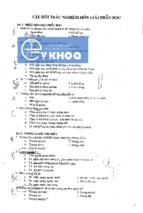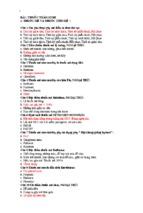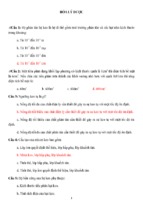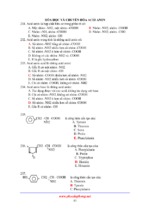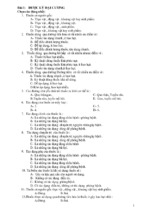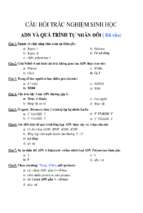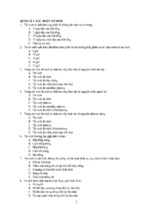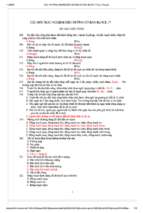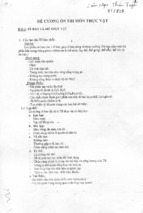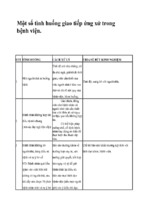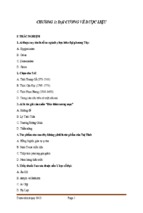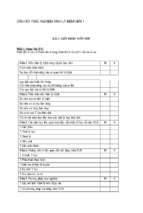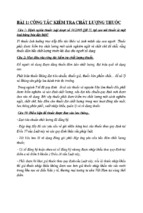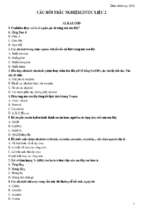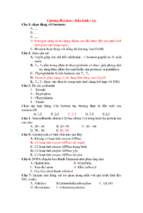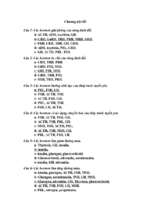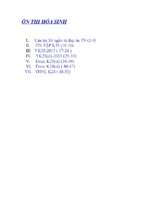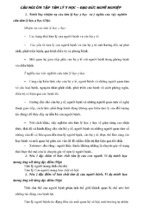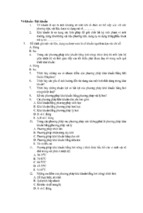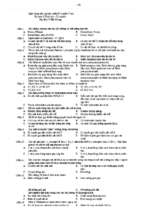I.
Fill the blank with suitable words
A.
1. These is usually an absence of............. in protoplasm.
2. The inside of an egg and protoplasm often have the
same............
3. Some cell do not have..............
4. Before it is digested, food is held in the cell by the ......:.....
5. All cells are similar in that they each have a cell...............
6. Leukocytes are phagocytic................... erythrocytes are not.
7. The gene lie in ...........
8. The body grows through cell ...........
9. Some cells can pass through capillary walls. In other words
capillaries are ………….
10. Some white blood cells can destroy bacteria. They are ..............
11. Platelets are very small particles which stick together to stop
bleeding, i.e. they are .............
12. Erythrocytes can ........... to get through narrow blood vessels and
then return to their original shape. In other words, erythrocytes are
………..
13. Blood cells cannot pass through artery walls. This means that
arteries are..............
14. Leukocytes can pass through capillary walls. This means that
capillary walls are .............to leukocytes
15. Leukocytes can move around in the tissues. In other words, they
are ……………
16. Veins are wide blood vessels with some muscle in their walls, i.e
veins are ……………… (blood vessels).
B.
17. Some cells move like the amoebae: they have the property
of ...........movement.
18. Arteries are long, tubular blood vessels which can bend and
stretch, i.e. they are ………… and ………..
19. Contraction of a muscle is a response to ..................
20. Most animals are able to move around because they have cells
which can......................
21. Muscles and glands receive .................from the brain and spinal
cord
22. When you flex your forearm, your biceps ……….
23. The ............... runs from the brain to the lower part of the back
24. Small ................. in the mouth release fluids that help break down
food
25. The basic unit of the nervous system is................
26. The vital organ of the circulatory system is...............
27. Places where a nerve impulse passes from one nerve cell to
another are ................
28. .................. nerves carry impulses from the brain or other nerve
centers to the muscles
29. ..............is a chemical substance produced by your body that
influences your body’s growth
30. The highest nervous structure which organizes and control the
body activities is ..................
31. Is the part of the brain that is located in the lower back of it,
which helps control and balance muscular activity.
32. The lowest part of the brain system ,continuos with the spinal
cord concerned with regulating action and vital organs is...........
33. The thick, whitish cord of nerve which extents from the medulla
to the second lumber vertebra is.............
C
34. The special cells in the bone are called..........
35. The active portion of the bone is ..............
36. The knee and the elbow joints are ...................
37. Calcium is produced in...................
38. The vertebral column.................. the spinal cord
39. The ribcage is attached in the front to the ...............
40. Calcium, which is a......................,is necessary in the development
of the body.
41. Ligaments are made up of..................... ..tissue.
42. Abduction means ……………..a part away from the body.
43. A hall-and-socket joint, such as the hip joint, allows a very wide
range of motion. It is a freely ................... joint
44. The joints between the bones of the head that protect the brain do
not move at all. They are.................joints
45. . Joints, which are formed where bones meet, allow the body
to ...............
D
46. The ………….. produces, stores, and destroys blood cells
47. A/ An …………..in veins prevent the fluid from flowing
backwards
48. A/an ………….. is a cavity, e.g. the left atrium of the heart
49. ………….. occur when veins stretch because valves do not work
well
50. In the lungs, blood exchanges carbon dioxide for …………..
51. Blood is pumped out to the body through the …………..
52. ………….. is the liquid portion of the blood.
53. The blood gets …………. from the lungs to carry to the cells.
54. The ………….. is used by the body to fight infection.
55. The blood gets …………. from the lungs to carry to the cells
56. …………. are absorbed by the blood from the duodenum and
brought to the cells
57. The …………. from the endocrine glands are transported by the
blood
58. Dilation and …………. of the blood vessels help regulate body
temperature
59. The blood helps maintain the fluid …………. of the body
60. Blood is continually …………. through a closed system in our
body
61. ..........is a very small blood vessel, often finer than hair
62. ................pumps blood into the aorta
63. ................ pumps blood into the lungs
64. ................. channels blood back to the heart
65. ................ channels blood away from the heart to the tissue
66. ............. artery supplies the heart tissue
67. The ............ pumps blood and oxygen around the patient's body
during a medical operation
68. Indigestion sometimes causes ..........., an unpleasant burning
feeling in your stomach or chest
69. A decrease in the blood supply to the heart causes a ..............
70. A .............treats diseases of the heart.
71. Air begins its journey to the lungs through the body at................
E
72. The nose and nasal cavities have the job of controlling the ............
of the air
73. Both food and air move through............
74. When food is swallowed, the epiglottis closes over the................
75. The hairs in the nose acts as .........................
76. The lungs are connected to the trachea by ..............
77. The air sacs of the lungs are encircled by ........
78. The blood vessels which surround the air sacs
receive ...................from them
79. . Simple .............. measures will reduce the risk of infection
80. Poliomyelitis is now a .............. disease
81. .................. is intended to prevent diseases of bad health
F
82. The part of the digestive tract below the diaphragm is called the
………………… tract
83. The portion of the digestive system that servers as both an air
passage and a food passage is the …………………….
84. The absorptive surface area of the muscle walls is increased by
millions of fingerlike projections called ……………………
85. In …………………….the appendix becomes inflamed and
infected
86. The …………… receives food, mixes it, carries on some
absorption, and moves food into the small intestine
87. The ……………stores bile from the liver and releases it when
needed
88. …………… largely consist of water, undigested material, mucus,
and bacteria
89. After food in the mouth is chewed, moistened, and softened by
saliva, it is ready to be ……………
90. Despite its name, the ……………is not straight
91. The ……………propels food from the pharynx into the stomach
92. A disease which is nearly always fatal if not detected early
is .......... It can often be treated by radiation or surgery
93. . The breaking down of food into a form that can be used by the
body cells is both …………….. and mechanical
G
94. The stomach breaks down food ……………..
95. Hormones are …………. that are secreted in one place but
work in another
96. A lot of water is necessary for the ……………..reduction of food
into its end products
97. .…………….. is the use of drugs to control and cure diseases.
98. .…………….. is concerned with studying the structure of
substances and the way they change.
99. .……………..the two substances are very similar.
100. . Also called a druggist, a…………… prepares drugs and
works in a shop.
101. ………….. is the scientific study of the chemistry of living
things.
102. You go to a …………… to buy drugs.
H
103. Many varieties of ......... cause pain, swelling, and stiffness in
the joints, particularly among the elderly
104. You were outside in the heat of the sun for too long. You have
a .................stroke
105. A ................... is a doctor who perform operations.
106. To avoid infection, operations are performed in a very clean or
.............. surroundings
107. ........... surgery is sometimes undertaken before corrective
surgery.
108. An anesthetic drug which dulls the senses in one area of the
body only is a .......................... anesthetic
109. When a blood transfusion is given, the .................... of the two
bloods must match.
110. Prior to an operation, a patient is usually given an ............... to
empty the colon of waste.
111. The anesthetist must keep careful watch of the
patient's ............ throughout the operation
112. The surgical................. covering a wound are changed
frequently after an operation.
113. A patient on the operating table usually has a ............. on one
arm and a ...........on the other dripping in an intravenous solution.
114. An.............. surgeon repairs bone injuries
115. He suffered from a temporary ................of memory
II.
Passage 1
Read the following passage and answer the questions below
All living things are able to take note of and respond to various factors in the
surrounding world. This ability depends on a highly organized system called
the nervous system. This system consists of the brain and the spinal cord and
is known as the central nerves system. Connected with the brain and spinal
cord are peripheral nerves including the twelve cranial nerves, which arise in
the brain and serve mostly the sense organs.
Another part of the body's communications network is the automatic system.
This system affects the automatic or involuntary actions of the internal
organs, such as the heart, blood vessels, lungs, stomach, intestine, kidneys,
bladder and sweat glands.
An important function of the nervous system is to pick up sensations of
light, sound, touch, taste, heat, cold, pain... etc....... These sensations are
carried from sense organs to the brain over the sensory nerves. The brain
receives these messages of sensations and reacts to them, makes plans, and
sends orders to for action. These orders are carried by the motor nerves to
the muscles of a particular part of the body. Thus the brain is the control
center of the entire nervous system. It is a soft, spongy mass of tissue
surrounded and protected by the bones of the cranium. Both brain and spinal
cords consist of two kinds of nervous tissue called grey matter because of
nerve cell bodies, white matter is made up of nerve fibers.
The basic unit of the nervous system is the nerve cells or neuron. Like all
cells of the human body, the neuron contains a nucleus which is surrounded
by cytoplasm. All neurons are, however, distinguished from other body cells
by thin fibers or extensions, called dendrites and axon. A neuron may have
many dendrites, but each neuron has only one axon. Dendrites are the parts
of the nerve cells that receive a stimulus from any part of the body. The
stimulus passes into the nerve cell and then into the axon. The axon carries
the impulse along to the dendrite of another nerve cell. The nerve fibers of
the connecting nerve cells do not meet or even touch each other at their
points of connection. They communicate their impulse chemically across
gaps called synapses
1. What does the nervous system consist of ?
....................................................................................................
2. What is the function of the nervous system?
.................................................................................................................
3. How are sensations carried to the brain?
.................................................................................................................
4. How different are neurons from other cells?
.................................................................................................................
5. Do nerve cells meet each other? How can they conduct messages?
.................................................................................................................
Passage 2
People have tried to cure medical problems by cutting into the body ever
since ancient times. Surgical operations are depicted on the tombs of the Egyptian
pharaohs, dating from 3000 BC. These early operations were painful and
hazardous. A patient whose leg needed to be amputated did not have the benefit of
an anesthetic drug to ease the pain. Alcohol was often used to dull the pain
somewhat. And once the leg had been removed, the patient risked infection because
the use of antiseptics was unknown.
Today this has all changed. Operations are now performed under sterile conditions.
A variety of anesthetic drugs are available to reduce the pain. Great care is taken
after each operation to avoid infection. In addition, the hospital stay has been
reduced to a week or less for most operations.
During this century in particular, major advances have been made. Operations are
now performed that had not even been imagined fifty years ago. The heart can be
opened and repaired in open heart surgery. Clogged blood vessels can be cleaned
out or replaced. Kidneys can be transplanted from one person to another. A lung or
part of the stomach can be removed without impairing the patient's ability to lead a
normal life.
Most operations are performed by surgeons who specialize in one area of surgery.
An orthopedic surgeon, for example, repairs broken bones while a neurosurgeon
handles cases involving malfunctioning nerves. A plastic surgeon repairs and
replaces limbs, features, and organs while a thoracic surgeon operates on patients
with chest and respiratory ailments. There are also heart surgeons and brain
surgeons, among others.
Most patients who receive surgical treatment have been referred to the surgeon by
their own physician. He has diagnosed a problem which he feels can be best
corrected by an operation and suggests that the patient seek the advice of a surgeon.
The surgeon may not agree with the physician, however. Surgeons themselves often
disagree about the practicality of performing an operation. Some advise surgery at
the first sign of a problem while others wait until a patient manifests severe
discomfort. Frequently a surgeon will perform exploratory surgery to learn more
about the patient's problem before undertaking actual corrective surgery
1. What were the operations in the past like? Why so?
............................................................................................................
2. Why is surgery nowadays considered safer?
............................................................................................................
3. What are some operations which have been perfected in recent years?
............................................................................................................
4. What does a neurosurgeon expert in?
............................................................................................................
5. When do you think is the best time for a surgeon to perform s surgery?
............................................................................................................
Passage 3
Heart disease can appear in a variety of forms. Some can be treated
successfully. Other heart ailments are fatal, either because they are diagnosed too
late or because the damage caused is too extensive. Doctors can often predict heart
problems by measuring the rate of the heartbeat, called the pulse, and from the
blood pressure.
One condition which can be treated by changing the environment is arteriosclerosis
or hardening of the arteries. With this disease, the inner walls of the arteries are
gradually thickened by layers of fatty material, narrowing the channel for the
passage of blood. Blood clots may form and block the circulation entirely. One way
to decrease the likelihood of this condition is by reducing the cholesterol content of
the diet, emphasizing vegetable oils, avoiding smoking and increasing exercise.
A patient who suffers a heart attack has what doctors call a coronary thrombosis
leading to myocardial infarction or cardiac arrest. One or more of the arteries
supplying the heart muscle with blood becomes narrowed by a blood clot.
Symptoms include pain in the chest, shortness of breath and nausea.
Another major killer in the twentieth century is cancer. Cancer is characterized by
an unrestrained growth of abnormal cells. There are three main types of cancer. A
carcinoma originates from the surface cells of the skin or the linings of the internal
organs. A sarcoma attacks the muscles, bones, tendons, cartilage, fat, blood vessels,
lymph system or connective tissue. Leukemia afflicts the blood forming cells.
Some cancers grow slowly; others spread rapidly, doubling in bulk in days. Cancers
can appear anywhere in the body but some common sites are the lungs, the breasts,
the uterine cervix, the skin, the colon, and the blood.
Cancer is fatal if it is untreated but it can often be cured in the early stages. As soon
as a tumor is discovered, exploratory surgery is undertaken and a biopsy for
examination of the tissue is performed. If the tumor is malignant, it may either be
removed surgically or treated with radiation or chemotherapy.
The causes of cancer remain an enigma to scientists. Some of the accompanying
conditions are known, however, including excessive cigarette smoking,
overexposure to x-rays and sunlight, and contact with certain chemicals. A virus
may be responsible; or a tendency to cancer may be inherited. Scientists are now
conducting extensive research to learn more about the disease
1. Why is heart disease fatal ?
............................................................................................................
2. What is myocardial infarction? What are its symptoms?
............................................................................................................
3. What is cancer ? where can cancer commonly appear?
............................................................................................................
4. Explain what happens to a victim of cancer. Why is cancer so feared?
............................................................................................................
5. What is the trealments for cancer in the early stage?
............................................................................................................
Passage 4
People notice changes in their bodies which they associate with illness.
These are called symptoms. The most clearly recognizable symptom is pain. A pain
in the stomach may indicate simple indigestion or a more serious ailment such as
an ulcer or dysentery. A headache is associated with colds, the flu, and head injuries
while a pain in the chest may be a warning of a heart attack or lung trouble.
Other symptoms of disease include coughing and bleeding. A cough may be dry or
it maybe produce a lot of phlegm or sputum. It is associated with ailments of the
throat, chest, and lungs. Bleeding may be severe as in hemorrhage or minimal as
with a small abrasion or cut.
Fainting or dizziness is other symptoms that something is wrong. They may
indicate a low red blood cell count, a condition or other injury to the brain.
Nausea and vomiting are associated with stomach and intestinal disorders such as
flu, food poisoning, or dysentery. Chest pain or a congested feeling can be a
symptom of heart trouble while sweating, itching, and rashes are skin
manifestations of problems such as allergies, or even cancer
Someone who experiences these symptoms should try to determine if they are
characteristics of a serious ailment or a common one. If the ailment is not serious, it
can be treated without medical advice. If serious, however, a doctor should be
consulted.
The common cold is a good example of an ailment which does not require expert
medical attention. Most colds are caused by viruses rather than getting wet or
standing in a draft, as is the common belief. It is true, though, that getting chilled
can lower one's resistance and make one more susceptible to attack by the virus.
The symptoms of a cold may include a runny nose, a cough, a sore throat, a fever,
and various aches. None of the antibiotic drugs, such as penicillin, are effective in
treating a cold. Drinking tea with honey and whiskey, a common home remedy,
does not cure a cold nor does taking massive doses of Vitamin C. About all one
can do is stay in bed and rest for five to seven days duration of the illness. Happily,
most virus infections in otherwise healthy people are self-limited.
While common available antibiotics do not help in the cure of a cold, other
medications can relieve some of the accompanying aches. Aspirin, a common pain
reliever, minimizes the headaches and other muscle aches. Gargling with salt water
or sucking lozenges can soothe a sore throat. An antihistamine may decrease the
stuffiness of the nose. And a prescription cough medicine with codeine or any other
mild narcotic will suppress the urge to cough.
1. What kinds of diseases are mentioned in the text?
........................................................................................................
2. List the symptoms mentioned in the text
........................................................................................................
3. What is the cause of the common cold?
........................................................................................................
4. What are the symptoms when you catch a cold?
........................................................................................................
5. Is antibiotics used to cure a cold? Why or why not?
........................................................................................................
Passage 5
- There are more than 200 bones in the human body at maturity. They are of three
principle types _ long as in lower arms, the thighs, and legs, and collar bones. The
breastbones, the ribs, and certain bones of the skull are called flat bones. Irregular
bones are of many different sizes and shapes. Some irregular bones are found in
hands, feet, ears, pelvis, girdle and spinal column.
Bones contain living cells. The hard outer portion of the bone contains special cells
called osteocytes. This outer bone is largely made up of mineral called calcium.
The active portion of the bone is the material inside, called bone marrow. The
marrow looks like a sponge. These active cells manufacture the hard outer layer of
the bone and red blood cells. Certain types of white blood cells are also made by
the marrow.
More than 20 percent of the weight of living bone is water. Of the remaining 80
percent, about 75 percent is minerals and 25 percent organic matter. However,
newly formed bones may have a considerably higher percentage of organic material
in relation to minerals.
The minerals are salt or compounds of calcium, phosphorus, magnesium, and other
elements. These salts deposits greatly strengthen the tough organic matrix, the
foundation of the bone.
The organic matrix is about 97 collagen, a type of protein fiber that is also found in
tendons, skin and connective tissue. The remaining 3 is a cement-like substance,
called ground substance, which is composed of extracellular fluid plus a sulfate and
an acid compound.
One type of cell is the osteoblast, which is associated with the construction or
deposition of new bone material and the repair of broken bones. A small amount of
osteoblastic activity occurs continually in all living bones so that at least some new
bone matrix is constantly being formed. The matrix in turn possesses a special
property, which causes calcium phosphate (Ca PH04) precipitation. During this
early mineralization of bone, these initial deposits of calcium and phosphate are
gradually transformed into a more permanent type of calcium salt. This
transformation into the harder and more durable crystals requires anywhere from
several weeks to months.
1. How can bones be classified?
..........................................................................................................
2. What is marrow? How important is it?
.............................................................................................................
3. Which is more in newly formed bone, organic or inorganic material?
.............................................................................................................
4. What is the composition of the bone? What percentage do they make up?
.............................................................................................................
5. Which causes the mineralization of bone?
.............................................................................................................
III.
Read the following passage and then circle the correct answer
Passage 1
There are many causes of headaches, and most people suffer them at some time or
other. Although doctors have come a long way from the old days, when headaches
were ascribed to evil spirits and treatments ranged from cutting our part of the skull
to concoctions of cow brain and goat dung, they are still not sure what sets off
headaches.
The most significant advance has been the acceptance that they are not the result of
emotional stress. Until recently, many doctors thought that imbalances in the body’s
systems were to blame, but experts now believe it is the brain itself. They point to
malfunctioning chemicals, such as serotonin, whose job it is to send messages to
regulate the contraction and dilation of blood vessels in the brain.
Monosodium glutamate, a flavor enhancer used in Chinese cooking, can cause
headaches in some people, as do many other common foods. Red wine, aged
cheese, coffee, chocolate, nuts, and preserved meats contain nitrates, caffeine, and
tyramine, chemicals that may produce pounding headaches.
Even though the exact culprit has yet to be found, there are plenty of treatments for
prevention or cure. Over-the-counter preparations such as aspirin are fine for
treating the occasional headache, but often exacerbate severe cases. Beta blockers,
usually used for lowering blood pressure, seem to head off migraines.
Antidepressants are effective, too. But doctors also recommend non-drug
treatments such as relaxation techniques, which can be used in combination with
medication, and diet modification, to cut out foods that cause attacks.
1. According to the passage, many years ago, one way doctors tried to cure
headaches was by …
A. praying to spirits.
B. sacrificing cows and goats.
C. operating on the patient’s head.
D. writing prescriptions.
2. It is no longer believed that headaches are caused by …
A. emotional stress.
B. malfunctioning chemicals in the brain.
C. certain kinds of foods.
D. contraction and dilation of blood vessels.
3. According to the passage, doctors now believe that headaches are related to
…
A.
imbalance in the body’s systems.
B.
chemicals in the brain.
C.
emotional stress.
D.
high blood pressure.
4. According to the passage, beta blockers can be used to ..
A.
treat migraines.
B.
cause migraines.
C.
contract blood vessels.
D.
treat depression.
5. According to the passage, severe headaches cannot be successfully treated
by …
A.
beta blockers.
B.
aspirin.
C.
relaxation techniques.
D.
serotonin.
ĐA: 1: C
2: A
3: B
4: A
5:B
Passage 2
Whether one is awake or asleep, the brain emits electrical waves. During
wakefulness, the waves are recorded at about ten small waves per second. With the
onset of sleep, the waves become larger and slower. The largest, slowest waves
occur during the first three hours of sleep. Mental activity slows down but does not
stop. In fact, if awakened from slow-wave sleep, a person can often remember
vague thoughts that occurred during that period of sleep.
During sleep, intervals of small, fast waves also occur. These waves are similar to
those experienced while awake. The eyes move rapidly, and it appears to the
observer that the sleeper is watching some event. Sleepers who are awakened
during this rapid-eye-movement sleep will often recall the details of dreams they
have been having. Sleep of this kind is called dreaming sleep or rapid-eyemovement sleep, also known as REM sleep.
In a period of eight hours, most sleepers experience from three to five instances of
REM sleep. Each instance lasts from five to thirty minutes with an interval of at
least ninety minutes between each one. Later instances of REM sleep are usually of
longer duration than are instances earlier in the eight-hour period.
People who suffer sleep deprivation experience fatigue, irritability, and loss of
concentration. Sleep is essential because it regenerates the brain and the nervous
system. Slow-wave sleep may be especially helpful in restoring muscle control,
whereas REM sleep may be more important in revitalizing mental activity. It
appears that both kinds of sleep are necessary, and the recuperation of sleep of one
kind will not compensate for a lack of the other kind of sleep.
1. What is the author's main purpose in the passage?
A. To describe REM sleep
B. To explain sleep deprivation
C. To discuss the two types of sleep
D. To recommend an increase in the number of hours of sleep
2. How many times per night do most sleepers experience REM sleep?
A. Eight
B. Three to five
C. Five to thirty
D. Ninety
3. The word vague in paragraph 1 could best be replaced by
A. familiar
B. indefinite
C. unpleasant
D. detailed
4. The author mentions all the following as characteristics of REM sleep EXCEPT
A. vague thoughts
B. smaller brain waves
C. eye movements
D. dreams
5. It can be inferred from the passage that students who are writing term
papers
A. require slow-wave sleep to increase mental activity
B. can stay up all night working and recover the sleep they need by
sleeping for a few hours the next afternoon
C. need REM sleep to restore mental functioning
D. do not need as much sleep because of the heighened brain waves
involves in creative activity
ĐA: 1: C
Passage 3
2: B
3: B
4:A
5:C
As heart disease continues to be the number-one killer in the United States,
researchers have become increasingly interested in identifying the potential risk
factors that trigger heart attacks. High-fat diets and "life in the fast lane" have long
been known to contribute to 5 the high incidence of heart failure. But according to
new studies, the list of risk factors may be significantly longer and quite surprising.
Heart failure, for example, appears to have seasonal and temporal 10
patterns. A higher percentage of heart attacks occur in cold weather, and more
people experience heart failure on Monday than on any other day of the week. In
addition, people are more susceptible to heart attacks in the first few hours after
waking. Cardiologists first observed this morning phenomenon in the mid-1980,
and have since 15 discovered a number of possible causes. An early-morning rise in
blood pressure, heart rate, and concentration of heart stimulating hormones, plus a
reduction of blood flow to the heart, may all contribute to the higher incidence of
heart attacks between the hours of 8:00 A.M. and 10:00 A.M.
In other studies, both birthdays and bachelorhood have been implicated as
risk factors. Statistics reveal that heart attack rates increase significantly for both
females and males in the few days immediately preceding and following their
birthdays. And unmarried men are more 25 at risk for heart attacks than their
married counterparts.
Though stress is thought to be linked in some way to all of the
aforementioned risk factors, intense research continues in the hope of further
comprehending why and how heart failure is triggered
1. What does the passage mainly discuss?
(A) risk factors in heart attacks
(B) seasonal and temporal patterns of heart attacks
(C) cardiology in the 1980s
(D) diet and stress as factors in heart attacks
2. the word “potential” could best be re-placed by which of the following?
(A) harmful
(B) primary
(C) unknown
(D) possible
3. The word “trigger” as used in line 3 is closest in meaning to which of the
following?
(A) involve
(B) affect
(C) cause
(D) encounter
4. According to the passage, which of the following is NOT a possible cause of
many heart attacks?
(A) decreased blood flow to the heart
(B) increased blood pressure
(C) lower heart rate
(D) increase in hormones
5. The word “phenomenon” in line 14 refers to which of the following?
(A) habit
(B) illness
(C) occurrence
(D) activity
ĐA: 1: A
2: D
3:C
4: C
5: A
Passage 4
1. According to the author, we might call our eyes and ears "transformers"
because :
A. they sense light and sound
B. they create electrical impulses
C. the brain can interpret the input
D. the messages travel in the brain
2. Which of the following is closest in meaning to the word "admits" ?
A. Selects
B. interprets
C. lets in
D. focuses on
3. What does the word "them" refer to?
A. light waves
B. processes
C. eyes
D. messages
4. The word "bundle" could best be replaced by which of the following?
A. Group
B. grow
C. branch
D. settle
5. The word "split" as used is closest in meaning to which of the following?
A. Tear
B. fracture
C. separate
D. crack
6. which part of the passage best decribes the first step in tranforming light into
electrical impulses?
A. Lines 1-2
B. Line 2-6
C. Line 7-8
D. Line 8-9
7. . According to the passage, when input from the right visual field goes into the
left side of the brain, what happens?
A. The nerve fibers bundle together.
B. The optic nerves split.
C. The retina receives light waves.
D. Input from the left field goes to the right side
8. The phrase "carried out" could best be replaced by which of the following?
A. brought over
B. taken away
C. accomplished
D. maintained
9. . Which of the following is most similar to the word "vibration" ?
A. Sound
B. movement
C. light
D. heat
10. . According to the passage, optic nerves eventually_____________________
A. bend
B. split
C. admit light waves
D. become messages
ĐA:
1: B
2: C
3:A
4:A
5:C
6:
7:D
8:C
9:B
10:B
Passage 5
There are some diseases for which we know no cure. For many of these, however,
scientists have been able to discover a means of prevention. Smallpox is such a
disease.
- Xem thêm -

